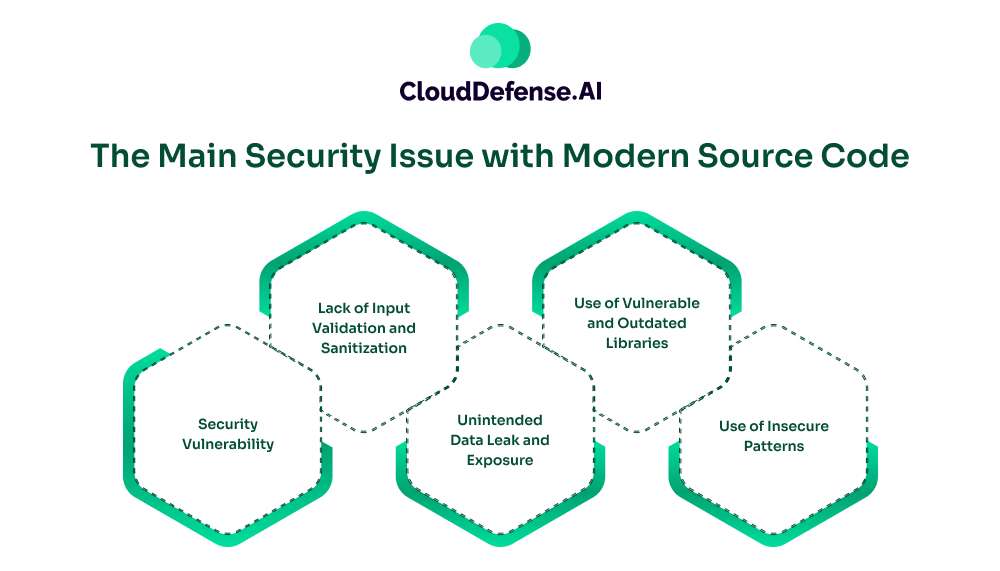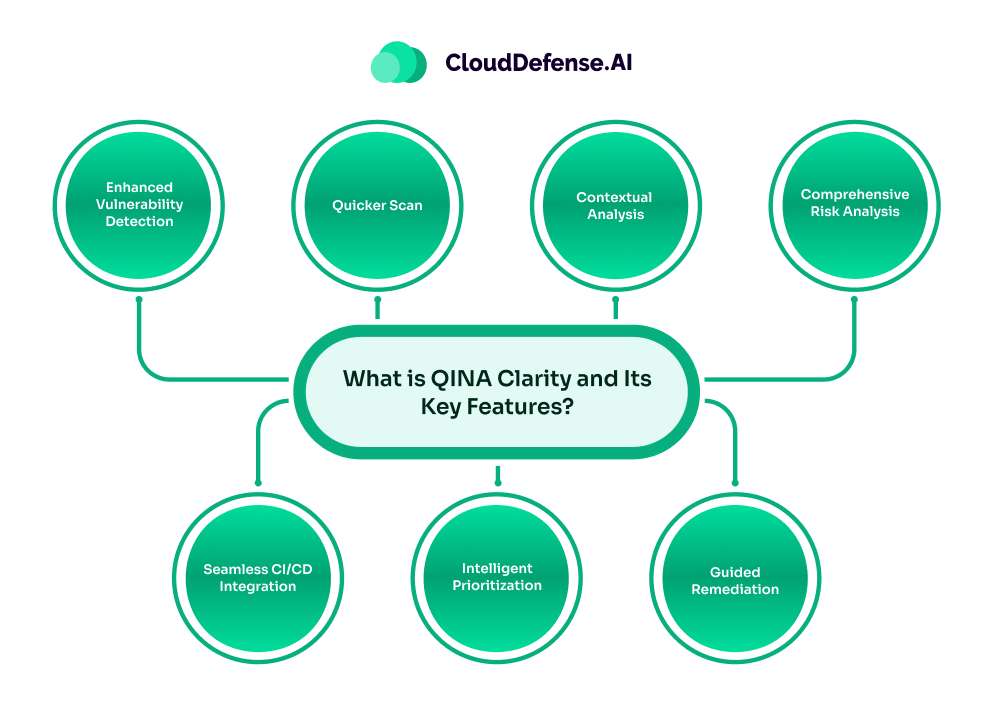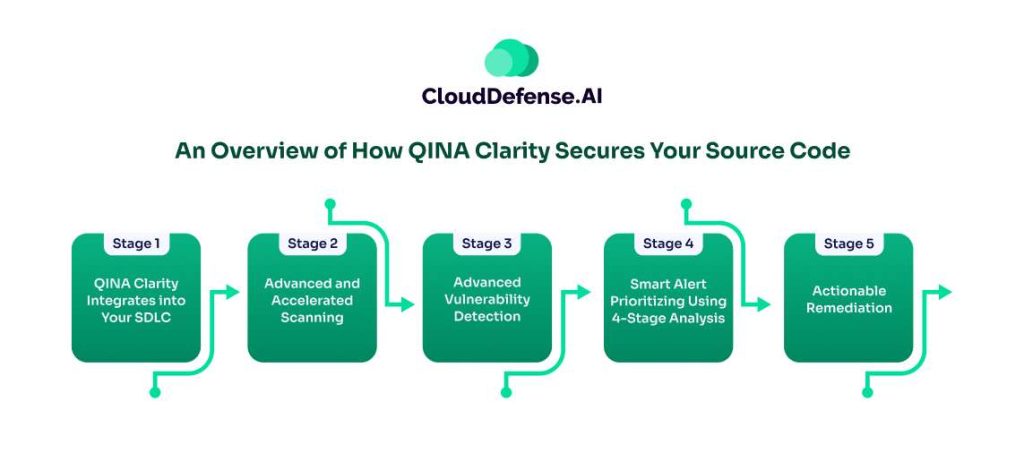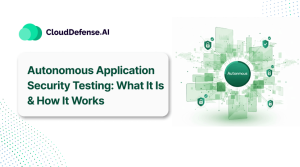With time, developer’s reliance on AI-based code editors is increasing. It is estimated that in 2024, AI code assistants were used to write approximately 250 billion lines of code for various development tasks. According to the latest statistics, around 50% of applications are developed using AI-generated code. Well, AI code editors help in productivity and a fast dev cycle.
However, it also introduces a wide attack vector due to potential AI-generated vulnerabilities. It has been observed that a large number of code suggestions by AI-based code editors are vulnerable. So it boils down to the question: how to secure your source code? QINA Clarity from CloudDefense.AI serves as the answer. It is a powerful and next-gen AI SAST that is built for developers to secure their source code. Today we will explore how to secure source code with QINA Clarity before production.
The Main Security Issue with Modern Source Code

Modern applications are often built on AI-based code. They not only streamline the development workflow but also enable developers to quickly deliver applications to the market. However, this introduces several security risks. These risks are:
- Security Vulnerability: Modern source code is often based on code from AI-code editors that are often sourced or trained on flawed datasets. It introduces vulnerabilities like SQL injection and XSS in the application. Moreover while using AI code editors, they often avoid prioritizing security best practices to cope with high-velocity development. However, it leads to adding codes that are functional but are vulnerable to attacks.
- Lack of Input Validation and Sanitization: It is a critical issue that occurs when developers add code without proper input validation and sanitization. In many cases, developers accept AI code without validating its type, format, or range. Plus, they often fail to sanitize the code to maintain high productivity in the SDLC. As a result, it leads to a wide array of security issues like data theft, application crashes, and unauthorized data modification.
- Unintended Data Leak and Exposure: AI-based codes often unintentionally leak sensitive data like API keys or proprietary algorithms. Many AI models often have access to organizational data for better context. But due to this, it often embeds data in the code. Moreover, to execute certain functions it often incorporates sensitive data into the output. A lot of secrets like API keys
- Use of Vulnerable and Outdated Libraries: Modern applications rely on third-party libraries and other dependencies during development. However, some of the libraries that are utilized are outdated carrying known security vulnerabilities. Similarly, AI code editors on some occasions use poorly managed dependencies that introduce security threats to the project.
- Use of Insecure Patterns: Developers while using AI code editors involve the use of common coding patterns to bring efficiency in the development process. However, these codes are sometimes insecure. When these codes are committed without proper validation it often leads to boilerplate code, leading to the elimination of security checks.
What is QINA Clarity and Its Key Features?

QINA Clarity is a modern AI-powered SAST that helps development teams with the accurate detection of vulnerabilities while minimizing false positives. It acts as a smart scanner that understands the context, performs intelligent LLM analysis, and provides developers with codes that need to be fixed immediately.
Importantly it reduces noise in the CI/CD pipeline and helps the DevSec team to remediate immediately. It integrates early in the SDLC and helps the developers with actionable remediation steps before the code is deployed.
This AI SAST is a powerful tool that offers some key features to developers, helping them to perform early bug detection. These key features are:
- Enhanced Vulnerability Detection: It is based on AI, LLM, and ML to analyze the source to precisely identify vulnerabilities. It can identify subtle patterns or nuance indications of vulnerabilities that are often missed by traditional tools.
- Quicker Scan: A key feature of QINA Clarity is that it holds the capability to scan the source code in under 2 minutes. It integrates seamlessly into the CI/CD pipeline and quickly scans the code as developers input them. By quickly identifying vulnerabilities at the beginning, helps developers mitigate them early.
- Contextual Analysis: This AI SAST tool is dependent on simple scanning and pattern matching, rather it understands the context. Importantly it makes use of LLM for contextual analysis and uncover the intent behind a code. The context-aware analysis helps in finding multi-stage vulnerabilities. It provides the developers with an overview of the vulnerability along with technology and vulnerability tags for better understanding.
- Comprehensive Risk Analysis: CloudDefense.AI’s AI SAST provides a comprehensive risk analysis for developers and the security team. It clearly explains to the developers the exploitability and impact of a specific vulnerability. It doesn’t involve any complicated explanation that would be difficult for everyone to understand.
- Seamless CI/CD Integration: A great feature of QINA Clarity is that it seamlessly integrates into your CI/CD pipeline. It doesn’t require any complex configuration or fine-tuning to plug directly into your SDLC and perform source code scanning.
- Intelligent Prioritization: One feature that sets this AI SAST stand apart is its intelligent prioritization of security findings through a 4-stage analysis. It performs an intelligent analysis where it takes all security findings and puts them through a 4-stage analysis process involving context extraction and LLM analysis. It helps in finding security findings that require immediate fixing and false positives.
- Guided Remediation: This AI-powered static analysis solution provides developers with a step-by-step guided remediation process. Depending upon the security finding analysis, it puts forward an easy-to-apply fix suggestion.
An Overview of How QINA Clarity Secure Your Source Code

QINA Clarity is a meticulously developed AI SAST from CloudDefense.AI that is meant for modern application development environments. It is not only fast and automated but also performs intelligent prioritization. Here is how to secure source code and mitigate vulnerabilities using QINA Clarity before it reaches vulnerabilities:
Stage-1: QINA Clarity Integrates into Your SDLC
To enable QINA Clarity to secure your source, it is important that the organization must be deeply embedded into your SDLC. It integrates seamlessly into the CI/CD pipeline to automate secure code scanning. It can be customized to perform security checks at specific stages.
Developers should work on utilizing QINA Clarity in the IDE which will help in identifying security threats while codes are written. Integration of this AI SAST in the SDLC should also involve merging it with the code repository. As a result, it is automated to perform secure code scanning at every new commit and pull request.
Stage 2: Advanced and Accelerated Scanning
Once QINA Clarity is integrated deeply into the SDLC, it performs a detailed static application security scanning using advanced algorithms. It performs a deep yet quick source code scanning to help developers maintain speed in the modern high-velocity dev cycle.
During code scanning, it prioritizes segments of the codebase that have been modified recently, have a history of known vulnerability indicators, or are risky based on the functionality. It also rapidly performs incremental scanning where it re-scans only the part of the code that has been after the last check. This enables quick scanning for code after every pull request and commits without degrading development speed.
Stage 3: Advanced Vulnerability Detection
QINA Clarity doesn’t just scan the code but also understands the context associated with the code. It performs advanced vulnerability detection which goes beyond standard pattern-matching techniques. Here is how it performs deep vulnerability detection:
- Enhanced Pattern Recognition: QINA Clarity is trained on billions of lines of code involving both secure and vulnerable code. This allows the AI SAST tool to identify vulnerability from subtle or intricate patterns. This enables the tool to not miss any vulnerable code.
- Contextual Understanding: A major highlight of this AI SAST is that it leverages AI, ML, and LLM to understand the context of the code. It thoroughly analyzes the data flow, control flow, and communication between component and business logic before flagging a code. Based on the analysis, the tool determines whether the code is exploitable or not.
- Behavioral Analysis: This AI SAST tool from CloudDefense.AI also analyzes the intended behavior of the code on the application. It performs a complete risk analysis and provides a complete visual code flow. If it finds any deviation that can lead to a security threat, it flags the code segment.
- Constant Learning: QINA Clarity is constantly from enormous datasets and current projects along with their dependencies. This helps the tool to become more aware of the application development environment, organizational policies, coding practices, and many other aspects. This helps enhance the accuracy of detecting vulnerabilities.
Stage-4: Smart Alert Prioritizing Using 4-Stage Analysis
QINA Clarity gathers all the security findings and puts them through a proprietary intelligent analysis process. The 4-stage analysis helps in transforming all the noise in the detection process into actionable insight. The 4-stage analysis pipeline involves:
- Dead Code Detection: In this stage, the AI SAST tool takes all the security findings from advanced detects and performs analysis to identify dead codes. Based on the analysis, it tags all the alerts with a reachability score.
- Context Extraction: After discarding dead code, it takes all the reachable security findings along with the surrounding code for context extraction. It analyzes the data and control flow to find out the contextual insights.
- LLM Analysis: The LLM takes all the reachable findings along with the context and performs reasoning based on the organization’s business intent and other aspects. It provides details regarding possible risks.
- Smart Classification: In the last stage, a final triage on the LLM output and reachability context is performed using smart classification techniques. It presents developers with alerts: Must Fix, Good to Fix, and False Positives.
It provides an actionable and prioritized report. This allows developers to focus on vulnerabilities that require immediate remediation. It also helps in cutting down time spent on analyzing false positives.
Stage-5: Actionable Remediation
QINA Clarity doesn’t only point out the codes that are vulnerable but also provides actionable remediation suggestions. It provides a detailed remediation insight with an easy-to-implement solution.
Developers just follow the steps to remediate the vulnerability in the code before it reaches the production stage. It also provides a vulnerability overview with proper vulnerability tags for better understanding. This AI SAST still doesn’t automatically remediate the vulnerability but soon will be implemented.
Conclusion
QINA Clarity is an advanced AI SAST tool that has empowered organizations to enforce security checks from the beginning of application development. It is helping them to properly implement the shift-left approach and deliver secure applications without compromising security.
It is gradually becoming a demanded tool for organizations that are committed to building a reliable and secure application. Through this guide, we have highlighted how to secure source code using QINA Clarity and go beyond the limitations of traditional tools. In essence, this tool secures your code through faster scanning, advanced detection, intelligent prioritization, and actional remediation.







